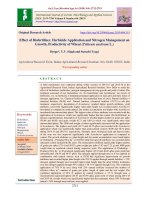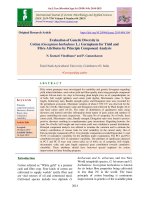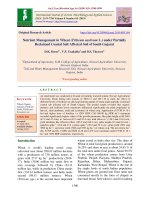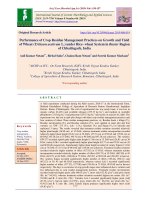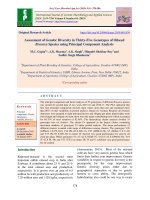Assessment of genetic diversity in promising bread wheat (Triticum aestivum L.) genotypes
Bạn đang xem bản rút gọn của tài liệu. Xem và tải ngay bản đầy đủ của tài liệu tại đây (280.88 KB, 9 trang )
Int.J.Curr.Microbiol.App.Sci (2018) 7(3): 676-684
International Journal of Current Microbiology and Applied Sciences
ISSN: 2319-7706 Volume 7 Number 03 (2018)
Journal homepage:
Original Research Article
/>
Assessment of Genetic Diversity in Promising Bread Wheat
(Triticum aestivum L.) Genotypes
Rajshree* and Satish Kumar Singh
Department of Plant Breeding and Genetics, Rajendra Agricultural University, Pusa,
Samastipur, Bihar - 848 125, India
*Corresponding author
ABSTRACT
Keywords
Wheat (Triticum
aestivum L.),
Genetic divesity
Article Info
Accepted:
07 February 2018
Available Online:
10 March 2018
An experiment with thirty three genotypes of bread wheat carried out to study the nature
and magnitude of divergence using Mahalanobis D2 statistics, in randomized block design
with three replications. The data for thirteen important quantitative traits were recorded
from the genotypes raised. The variability study indicated high to moderate phenotypic and
genotypic coefficient of variation accompanied by high heritability and genetic advance as
per cent of mean for traits, plant height, number of tillers per plant, flag leaf area,
chlorophyll content, canopy temperature, spike length, grains per spike, grain yield per
plot and harvest index indicating their importance in selection for yield improvement. The
thirty three genotypes of bread wheat were grouped into six clusters using Tocher’s
method. The genotypes in cluster III and cluster VI, exhibited high degree of genetic
diversity. Cluster I was suitable for spike length, flag leaf area, grains per spike, thousand
grain weight, and grain yield per plot. Days to fifty per cent flowering and harvest index
contributed maximum towards genetic divergence.
Introduction
Wheat (Triticum aestivum L.) is considered as
king of cereals and it provides foods to 36% of
the global population, contributing 20% of the
food calories. It is an important staple food of
many countries in the world and occupies a
unique position as used for the preparation of
a wide range of food stuffs. Over the past
century selection of desirable parents for
hybridization programme has been found as an
effective operating implement in developing
high yielding crop varieties upon which, the
modern agriculture can rely. Efficient and
economic crop improvement scheme refers to
the collection of superior alleles into a single
population. Genetic variability in a population
can be partitioned into heritable and nonheritable variation with the aid of genetic
parameters such as variance, genotypic
coefficient of variation, heritability and
genetic advance, which serve as a basis for
selection of some outstanding genotypes from
existing ones (Tsegaye et al., 2012). Choice of
parents is not only based on desirable
agronomic traits, components of yield and
extent of variability but also on heritability of
yield contributing traits. The environment, in
which selection is made, is also important
because heritability and genetic advance vary
676
Int.J.Curr.Microbiol.App.Sci (2018) 7(3): 676-684
with change in environment (Korkut et al.,
2001). The study of genetic variability reveals
about the presence of variation in their genetic
constitution and it is outmost important as it
provide the basis of effective selection. Grain
yield is a complex trait and highly influenced
by many genetic factors and environmental
fluctuations. In plant breeding programme,
direct selection for yield as such could be
misleading. A successful selection depends
upon the information on the genetic variability
and association of morpho-agronomic traits
with grain yield. In views of these facts, thirty
three wheat genotypes were evaluated in this
study to determine the magnitude of
variability among the germplasm and
grouping pattern of genotypes in different
cluster. To identify genetically diverse and
agronomically desirable genotypes for
exploitation in a breeding programme aimed at
improving grain yield potential of wheat.
Flag leaf area (cm2) = flag leaf length (cm) x
flag leaf width (cm) (Mokhtarpour et al.,
2010).
Harvest index was calculated as per the
formula (Huhn 2008).
H.I. =
Economic
yield
Biological
yield
100
Where,
Economic yield = Grain yield (g)
Biological yield = Total plant yield (g)
The data were analyzed using WINDOSTAT
version 9.1 software for computation of
analysis of variance, genotypic coefficient of
variation (GCV), phenotypic coefficient of
variation (PCV), heritability in broad sense
(h2b) and clustering by Tocher’s method.
Materials and Methods
Results and Discussion
The experiment was conducted in a
randomized block design with three
replications. The experimental materials were
sown during Rabi, 2015 keeping plot size 3.0
m × 2.5 m. In each replication each genotype
was grown in a plot of 5 rows of 3 meter
length each with a spacing of 22.5 cm between
rows. In order to compare the genotype
unbiaselly, uniform plant population was kept
in each row. Five random plants per genotype
per replication were tagged to record
observations on yield and yield attributing
traits viz., days to fifty per cent flowering,
days to maturity, plant height, number of
tillers per plant, spike length, flag leaf area,
chlorophyll content, canopy temperature,
relative water content, number of grains per
spike, grain yield per plot, harvest index,
1000-grain weight. Flag leaf length and width
of five randomly selected plants were taken by
measuring scale and flag leaf area was
calculated by following formula:
In the present investigation, Thirty three
diverse genotypes of bread wheat were studied
to assess their yield and yield related
attributing characters. The analysis of variance
clearly indicated that there was highly
significant variation among the genotypes for
all the traits studied. This in turn indicated that
there was sufficient variability in the material
studied, which could be utilized in further
breeding programme. Similarly, many earlier
workers, Bhushan et al., (2013), Degewione et
al., (2013), Fellahi et al., (2013), Kumar et al.,
(2014) and Yadav et al., (2014) reported high
variability for different traits in bread wheat
which provides ample scope for selecting
superior and desire genotypes by the plant
breeder for further improvement.
The phenotypic variances (Table 1) for all the
traits under studied were higher than the
genotypic variances (Yadav et al., 2006). This
677
Int.J.Curr.Microbiol.App.Sci (2018) 7(3): 676-684
may be due to the non-genetic factor which
played an important role in the manifestation
of these characters. Wide ranges of variance
(phenotypic and genotypic) were observed in
the experimental material for all the characters
under investigation. The maximum phenotypic
and genotypic variance exhibited by the traits,
grain yield per plot, grains per spike, harvest
index, chlorophyll content, plant height,
relative water content, days to fifty per cent
flowering and days to maturity. These findings
were in accordance of Singh et al., (2003),
Sen et al., (2007), Majumder et al., (2008) and
Kumar et al., (2009). The genotypic and
phenotypic coefficients of variation for grains
per spike and harvest index were found high
indicating the importance of this trait in
evaluation and selection of the genotypes.
These results are in agreement with Raj
Bahadur and Lodhi (1995), Singh et al.,
(2003), Yadav et al., (2006), Sen et al.,
(2007), Ali et al., (2008) and Kumar et al.,
(2014).
High heritability in broad sense were recorded
for all the characters namely tillers per plant,
flag leaf area, days to fifty per cent flowering,
chlorophyll content, canopy temperature,
relative water content, spike length, grains per
spike, days to maturity, 1000-grain weight and
grain yield per plot. High heritability value for
these traits indicated that the variation
observed was mainly under genetic control
and was less influence by environment. So,
these traits may be used as selection criteria
for yield improvement in confirmation with
the result of earlier workers viz., Islam et al.,
(2012), Kumar et al., (2014) and Fellahi et al.,
(2013). In the present investigation, the
characters, namely tillers per plant, flag leaf
area, chlorophyll content, canopy temperature,
spike length, grains per spike, grain yield per
plot and harvest index have high heritability
and genetic advance as per cent of mean. The
high heritability associated with high genetic
advance indicated, the variation was mostly
due to additive gene effects. Hence, direct
selection can be done through these characters
for future improvement of genotypes for
higher grain yield. Similar results were also
reported by earlier workers (Islam et al., 2012;
Singh et al., 2014 and Yadav et al., 2014).
Thirty three genotypes (including check) were
grouped into six clusters on the basis of D2
statistics (Table 2). Cluster I and IV had
maximum number of genotypes (9) viz., 21st
SAWYT307,
21st
SAWYT332,
34th
th
ESWYT146, 46 IBWSN1095, AKAW4900,
8th
EBWYT507,
LBPY-2014-7,
21st
SAWYT316 and LBPY 2013-1 in cluster I
and HD2643, PBW343, 3043, 46th
IBWSN1113, HD2733, HD2967, 34th
ESWYT124,, PBW373, 46th IBWSN1107 in
cluster IV respectively. Cluster II and V had
five genotypes each viz., 4051, 7004, 3054,
4043, HUW234 in cluster II and 6041,
HD2932, LBPY-2014-2, RAJ4120 and
DBW14 in cluster V respectively. Cluster VI
had four genotypes viz., 5011, 34th
ESWYT121, DBW15, DBW39. Cluster III
was solitary, comprising single genotype viz.,
GW2013-471. The clustering pattern showed
that there was no formal relationship between
geographical diversity and genetic diversity.
Similar studied based on D2 statistic was also
performed by Shoran and Tondon (1995),
Ribadia et al., (2007), Roy et al., (2009) and
Ferdous et al., (2011). Different clusters
comprises unique feature for different
characters under investigation. Cluster III had
the maximum mean value for thousand grain
weight, grain weight per plot, chlorophyll
content, relative water content and harvest
index. Cluster III had genotype with low mean
value for canopy temperature. Cluster I had
the genotype with the highest mean value for
tillers per plant, spike length, flag leaf area
and grains per spike. Cluster V may be
selected as a donor for dwarfness as well as
for early maturity (Table 3).
678
Int.J.Curr.Microbiol.App.Sci (2018) 7(3): 676-684
Table.1 Estimates of variability parameter of yield and yield attributing traits
Sl. No
1
2
3
4
5
6
7
8
9
10
11
12
13
Characters
Plant height (cm)
Days to 50 per cent flowering
Flag Leaf Area(cm²)
Numbers of Tillers per Plant
Chlorophyll content
Canopy temperature
Relative water content
Spike length
Number of grains per spike
Days to maturity
1000 grain weight
Grain yield per plot
Harvest Index (%)
σ2g
σ2p
GCV
PCV
h2 (Broad sense)%
GA as % of Mean
37.91
26.48
11.12
1.24
42.17
10.48
35.17
1.44
115.14
24.70
12.39
3589.82
103.85
96.20
27.12
14.81
1.87
46.31
14.88
55.63
1.61
126.54
31.52
14.73
4304.15
114.81
7.04
7.08
16.62
19.57
16.13
15.68
6.59
11.14
22.72
4.35
8.68
14.96
22.14
11.21
7.16
19.18
24.06
16.90
18.69
8.29
11.80
23.82
4.91
9.46
16.39
23.27
39.41
97.65
75.11
66.17
91.07
70.43
63.23
89.09
90.99
78.36
84.16
83.40
90.46
9.10
14.41
29.67
32.79
31.72
27.12
10.79
21.66
44.65
7.94
16.41
28.16
43.36
Where, σ2g = Genotypic variance, σ2p = Phenotypic variance, GCV= Genotypic coefficient of variation, PCV=Phenotypic coefficient of variation h 2=heritability,
GA= Genetic Advance
Table.2 Clustering pattern of 33 genotypes of bread wheat on the basis of D2 statistic
Cluster No.
No. of Genotypes within
cluster
I
II
III
IV
V
VI
9
5
1
9
5
4
Genotypes in cluster
21st SAWYT307, 21st SAWYT332, 34th ESWYT146, 46thIBWSN1095, AKAW4900, 8th EBWYT507, LBPY-2014-7, 21st SAWYT316, LBPY 2013-1
4051, 7004, 3054, 4043, HUW234
GW2013-471
HD2643, PBW343, 3043, 46th IBWSN1113, HD2733, HD2967, 34th ESWYT124,, PBW373, 46th IBWSN1107
6041, HD2932, LBPY-2014-2, RAJ4120,DBW14
5011, 34th ESWYT121, DBW15, DBW39
Table.3 Cluster mean for thirteen characters in bread wheat
Cluster No.
PH
TPP
SL
FLA
DFF
G/S
TGW
GW/P
CC
RWC
CT
DTM
HI
I
II
III
IV
V
VI
95.45
85.28
86.73
84.27
81.94
86.75
6.01
5.90
5.90
5.86
4.87
5.22
12.23
10.31
12.20
10.32
9.73
9.91
21.42
17.92
20.80
21.17
17.55
20.17
74.41
65.27
69.00
77.30
67.07
75.75
59.11
48.69
51.50
41.37
40.89
38.62
42.85
37.33
44.00
40.00
40.73
39.50
435.56
349.33
515.00
420.19
403.33
307.25
44.04
32.80
47.33
43.81
42.33
28.67
92.07
81.87
96.67
94.11
93.67
79.67
19.48
25.47
16.33
18.85
18.33
25.17
113.85
110.40
115.00
116.96
108.53
120.17
51.79
35.94
62.48
49.06
48.09
32.26
Abbreviations- Plant Height (PH), Tillers per plant (TPP), Spike length (SL),Flag Leaf Area (FLA), Days to 50 per cent flowering (DFF), Grains per spike
(GPS),1000-Grain weight (TGW), Grain yield per plot (GWP), Chlorophyll content (CC), Relative water content (RWC), Canopy temperature (CT), Days to
Maturity (DTM), Harvest Index (HI)
679
Int.J.Curr.Microbiol.App.Sci (2018) 7(3): 676-684
Table.4 Mean intra and inter cluster distance (D2) among six cluster in bread wheat
Cluster I
Cluster I
Cluster II
Cluster III
Cluster IV
Cluster V
Cluster VI
34.12
Cluster
II
138.36
22.67
Cluster
III
59.05
145.25
0.00
Cluster
IV
69.86
187.99
89.73
49.36
Cluster
V
115.56
93.52
51.46
125.17
32.27
Cluster VI
124.98
118.96
208.33
119.81
196.07
50.05
Table.5 Diverse bread wheat genotypes based on cluster mean and superior per se performance
for the traits under investigation
Sl.
No.
1
Characters
Cluster
Suitable Parents in Cluster
Plant Height (cm)
V
2
3
Tillers per plant
Spike length (cm)
I
I
4
5
Flag leaf area (cm2)
Days to fifty per cent
flowering
I
II
6
Grains per spike
I
RAJ4120
DBW14
LBPY2014-7
8th EBWYT507*
34th ESWYT146*
AKAW4900*
21st SAWYT332*
LBPY2013-1*
46th IBWSN1095*
21st SAWYT307*
LBPY-2014-7*
21st SAWYT316*
AKAW4900
7004*
4043*
4051*
3054*
HUW234*
21st SAWYT332*
46th IBWSN1095*
21st SAWYT307*
21st SAWYT316* LBPY-20147*
AKAW4900* LBPY2013-1*
34th ESWYT146*
8th EBWYT507*
7
8
9
10
11
12
Thousand grain weight
Grain yield per plot (g)
Chlorophyll content
Relative water content
Canopy temperature (0C)
Days to maturity
I
I
III
III
III
V
13
Harvest index
III
LBPY2013-1
LBPY-2014-7*
GW2013-471*
GW2013-471
GW2013-471
DBW14*
RAJ4120*
GW2013-471*
680
Per se
Performance
70.40
75.10
7.13
13.20
12.73
12.53
12.47
12.43
12.10
11.73
11.46
11.43
25.45
63.00
64.00
64.66
66.33
68.33
69.13
65.66
64.20
58.96
57.76
55.93
53.70
53.66
52.96
46.66
488.33
47.33
96.67
16.33
104.00
110.00
62.47
Int.J.Curr.Microbiol.App.Sci (2018) 7(3): 676-684
Cluster II was suitable for early flowering.
Therefore, these clusters may be chosen for
transferring the traits having high mean
values through hybridization programme.
Selection of genotypes based on cluster mean
for the better exploitation of genetic potential
also reported by Dwivedi and Pawar (2004),
Roy et al., (2009), Hailegiorgis et al., (2011)
and Desheva and Kyosev (2014). The highest
intra cluster distance (Table 4) was observed
in cluster VI followed by cluster IV, cluster I,
cluster V and cluster II indicating differences
in genotypes within cluster. Least intra cluster
distance was found in cluster II indicating that
close resemblance between the genotypes
presented in this cluster.
superiority for grain yield per plot based on
highest cluster mean and significant superior
per se performance. This genotype also
exhibited superiority for tillers per plant based
on highest cluster mean and superior per se
performance. GW2013-471 grouped in cluster
III exhibited superiority for chlorophyll
content and harvest index based on highest
cluster mean and significant superior per se
performance. GW2013-471 also exhibited
superiority for relative water content based on
highest cluster mean and superior per se
performance. This genotype also exhibited
superiority for canopy temperature based on
lowest cluster mean and superior per se
performance. RAJ4120 and DBW 14 grouped
in cluster V exhibited earliness in days to
maturity based on cluster mean (lowest) and
significantly superior per se performance
(Table 5). LBPY-2013-1 grouped in cluster I
exhibited superiority for thousand grain
weight based on highest cluster mean with
superior per se performance. RAJ4120 and
DBW14 of cluster V also exhibited
superiority for plant height based on lowest
cluster mean with superior per se
performance. 4051, 4043, 3054,7004,
HUW234 grouped in cluster II exhibited
earliness in days to fifty per cent flowering
based on cluster mean (lowest) and
significantly superior per se performance. 21st
SAWYT307,
21st
SAWYT332,
34th
th
ESWYT146, 46 IBWSN1095, AKAW4900,
8th
EBWYT507,
LBPY-2014-7,
21st
SAWYT316, LBPY2013-1 grouped in cluster
I exhibited superiority for spike length and
grains per spike based on highest cluster mean
with
significantly
superior
per
se
performance. AKAW 4900 grouped in cluster
I also exhibited superiority for flag leaf area
based on highest cluster mean with superior
per se performance.
The genotypes in cluster III and cluster VI
due to maximum inter cluster distance
between them, exhibited high degree of
genetic diversity and thus may be utilized
under inter varietal hybridization programme
(transgressive breeding) for getting high
yielding recombinants. Similar inter varietal
crosses may be attempted between genotypes
in cluster V and VI and cluster II and IV. The
lowest inter cluster distance was observed
between cluster III and V followed by cluster
I and III and cluster I and IV showing these
clusters were relatively less divergent and
crossing between them cannot produce
vigorous offspring (F1 progenies). These
results of genetic diversity study were in
agreement with the finding of Gupta et al.,
(2002), Ribadia et al., (2007) and Sanghera et
al., (2014) suggested that genotypes of most
diverse cluster may be used as parents in
hybridization programmes to develop high
yielding varieties.
In the present study, 33 diverse genotypes
were grouped into various cluster and suitable
diverse genotypes were selected based on
their cluster mean superiority and per se
performance for different characters. LBPY2014-7 grouped in cluster I exhibited
Acknowledgment
Authors wish to acknowledge Department of
681
Int.J.Curr.Microbiol.App.Sci (2018) 7(3): 676-684
Plant Breeding and Genetics, Rajendra
Agricultural University (RAU) Pusa for
providing materials and other support.
yield and its components in wheat
cultivars and land races under near
optimal and drought conditions.
Euphytica. 133 (1): 43-52.
Department of Agriculture and Corporation.
(2014). Agricultural statistic at a glance
(www. agricoop.nic.in).
Desheva, G., and Kyosev, B. 2014. Genetic
diversity assessment of common winter
wheat (Triticum aestivum L.). Emir.
Journal of Food Agriculture. 27(3):
283-290.
Dwivedi, A.N. and Pawar, I.S. (2004).
Evaluation of genetic diversity among
bread wheat Germplasm line for yield
and quality attributing traits. Haryana
Agriculture University Journal of
Research. 32: 77-80.
FAO. (2014). The state of food and
agriculture in Asia and the Pacific,
Bangkok
(www.
Fao.org/world/regional/rap/)
Fellahi, Z., Hannachi, A., Guendouz, A. And
Boutekrabt,
A.
(2013).
Genetic
variability, heritability and association
studies in bread wheat (Triticum
aestivum L.) genotypes. Electronic
Journal of Plant Breeding. 4(2): 1161.
Ferdous, M., Nath, U.K. and Islam, A. (2011).
Genetic divergence and genetic gain in
bread wheat through selection practices.
Journal of Bangladesh Agricultural
University. 9(1): 1-4.
Gupta, R.S., Tiwari, D.K., Deal, S.S. and
Singh, R.P. (2002). Genetic diversity of
bread wheat (Triticum aestivum L.).
New Botanist. 29: 1-7.
Hailegiorgis, D., Mesfin, M. and Genet, T.
(2011). Genetic divergence analysis on
some bread wheat genotypes grown in
Ethiopia. Journal of Central European
Agriculture. 12(2): 344-352.
Huhn. M. (2008). Comments on the
Calculation of Mean Harvest Indices.
Journal of Agronomy and Crop Science.
165(2-3):85-90.
References
Aharizad, S., Sabzi, M., Abolghasem, S.,
Mohammadi, and Khodadadi, E. 2012.
Multivariate analysis of genetic
diversity in wheat (Triticum aestivum
L.) recombinant inbred lines using
agronomic traits. Annals of Biological
Research. 3(5): 2118-2126.
Ali, Y., Atta, B.M., Akhter, J., Monneveux, P.
and Lateef, Z. 2008. Genetic variability,
association and diversity studies in
wheat
(Triticum
aestivum
L.)Germplasm. Pakistan Journal of
Botany. 40(5): 2087-2097.
Bergale, B. and Yildirim, M. 2001. Heat and
drought resistances criteria in spring
bread wheat: drought resistance
parameters. Scientific Research and
Essays. 5(13):1742-1745.
Bhusan, B., Bharti, S., Ojha, A., Pandey, M.,
Gourav, S.S., Tyagi, B.S. and Singh, G.
(2013). Genetic Variability, correlation
coefficient and path analysis of some
quantitative traits in bread wheat.
Journal of Wheat Research. 5(1): 21-26.
Bousba, R., Baum, M., Djekoune, A.,
Labadidi, S., Djighly, A., Benbelkacem,
K., Labhilili, M., Gaboun, F. and
Ykhlef, N. (2012). Screening for
drought tolerance using molecular
markers and phenotypic diversity in
durum wheat genotypes. World Applied
Sciences Journal. 16(9): 1219-1226.
Degewione, A., Dejene, T. And Sharif, M.
(2013). Genetic variability and traits
association in bread wheat (Triticum
aestivum L.) genotypes. International
Research Journal of Agricultural
Sciences 1(2): 19-29.
Dencic, S., Kastori, R., Kobiljski, B. And
Duggan, B. (2000). Evaluation of grain
682
Int.J.Curr.Microbiol.App.Sci (2018) 7(3): 676-684
Islam, E., Allahgholipour, M., Zarei, L. And
Kiani, M. (2012).Genetic analysis of
field and physiological indicators of
drought tolerance in bread wheat
(Triticum aestivum L.) using diallel
mating design. African Journal of
Biotechnology. 10(61):13071-13081.
Khodadadi, M., Mohammad, F. and
Miransari, M. (2011). Genetic diversity
of wheat (Triticum aestivum L.)
genotypes based on cluster and
principal component analyses for
breeding strategies. Australian Journal
of Crop Sciences. 5(17-24).
Korkut, K. Z., Baser, I. and Bilgin, O. 2001.
Genotypic and phenotypic variability,
heritability and phenotypic correlation
for yield and yield components in bread
wheat varieties. Acta Agronomica
Hungarica. 49(3): 237-242.
Kumar, B., Lal, G.M., Ruchi and Upadhyay,
A. (2009). Genetic variability Diversity
and Association of quantitative traits
with grain yield in Bread wheat
(Triticum aestivum L.). Asian Journal of
Agricultural Sciences. 1(1): 4-6.
Kumar, N., Markar, S., and Kumar, V.
(2014). Studies on heritability and
genetic advance estimates in timely
sown bread wheat (Triticum aestivum
L.). Bioscience Discovery. 5(1):64-69.
Kumar, S., Dwivedi, V.K. and Tyagi, N.K.
(2003). Genetic variability in some
metric traits and its contribution to yield
in wheat (Triticum aestivum L.).
Progressive agricultural. 3(1/2): 152153.
Lush, J.L. 1949. Heritability of quantitative
characters in farm animals. Proceedings
of 8th Congress of Genetics and
Heriditas. 35: 356-375.
Mahalanobis, P.C. 1936. On the generalised
distance in statistics. Proceedings of
National Institute of Science. India. 2:
49-55.
Majumder, D.A.N., Shamsuddin, A.K.M.,
Kabir, M.A. and Hassan, L. (2008).
Genetic variability correlated response
and path analysis of yield and
contributing traits at spring wheat,
Journal of Bangladesh Agricultural
University. 6(2) 227-234.
Mokhtarpour, H., Teh, B.S.C Saleh., G.
Selamat., A.B Asadi. And M.A
Kamkar. B. (2010). Non-destructive
estimation of maize leaf area, fresh
weight, and dryweight using leaf length
and leaf width. Communications in
Biometry and Crop Science. 5(1):19–26.
Raj Bahadur and Lodhi, G.P. (1995).
Variability and association studies in
wheat. Crop research. 9(2): 313-316.
Ranjana, K.H., Dobariya, K.I., Ponkia, H.P.
and Jivani, L.L. (2013). Genetic
divergence in macorni wheat (Triticum
durum Desf.). Journal of Maharashtra
Agriculture University. 32(1): 32-34.
Ribadia, K.H., Dobariya, K.I., Ponkia, H.P.
and Jivani, L.L. (2007). Genetic
divergence in macorni wheat (Triticum
durum Desf.). Journal of Maharashtra
Agriculture University.32 (1): 32-34.
Roy, B.K., Lal, G.M., Ruchi. And Upadhyay,
A. (2009). Genetic variability, diversity
and association of quantitative traits
with grain yield in bread wheat
(Triticum aestivum L.). Asian Journal of
Agricultural Sciences. 1(1):4-6.
Sanghera, G.S., Kashyap, S.C., Rana, V. and
Parry,
G.A.
(2014).
Agromorphological and genetic diversity
among elite wheat genotypes grown
under Kashmir conditions. International
Journal of Current Research. 6(8):
7735-7740.
Sen, C., and Tom, B., (2007). Character
association and component analysis in
wheat
(Triticum
aestivum
L.).
Agricultural Research Information
Centre, Crop Research, Hisar India. 34
(1/3):166-170.
683
Int.J.Curr.Microbiol.App.Sci (2018) 7(3): 676-684
Shoran, J. and Tandon, J.P. (1995). Genetic
divergence of winter wheat (Triticum
aestivum L.). Indian Journals of
Genetics and Plant Breeding. 55 (4):
406-409.
Singh, A.K., Singh, S.K, Garg, H.S, Kumar,
R. And Choudhary, R. (2014),
Assessment
of
relationship
and
variability of morpho-phygiological
characters in bread wheat (Triticum
aestivum L.) under drought stress and
irrigated conditions. The Bioscan. 9(2):
473-484.
Singh, M., Swarnkar, G.B., Lallu and Prasad,
L. (2003). Genetic variability and path
coefficient analysis in advances
generation of bread wheat under rainfed
condition. Plant Archives. 3(1): 89-92.
Singh, S.B., Singh, J.P. and Singh, T.B.
(1997).
Variability
pattern
in
agromorphological characters in wheat
(Triticum aestivum L.). Crop Research.
13(2): 391-396.
Singh, T., Sharma, A., and Alie, F.A., (2009).
Morpho-physiological traits as selection
criteria for yield improvement in
mungbean
(Vigna
radiata
(L.)
Wilczek). Legume Research. 32 (1):3640.
Tsegaye, D., Dessalegn, T., Dessalegn, Y. and
Share, G. 2012. Analysis of genetic
diversity in some durum wheat
(Triticum durum Desf) genotypes grown
in Ethiopia. African J. Biotech. 11(40):
9606-9611.
Yadav, S.K., Singh, A.K. (2014). Assessment
of genetic variability, and diversity for
yield and its contributing traits among
CIMMYT based wheat germplasm.
Society for advancement of wheat
research. 6(2): 154-159.
Yadav, S.N., Vadaya, S.N.P., and Kumar, P.,
(2006). Genetic divergence in wheat.
Indian Journal of Genetics. 4:104-105.
How to cite this article:
Rajshree and Satish Kumar Singh. 2018. Assessment of Genetic Diversity in Promising Bread
Wheat (Triticum aestivum L.) Genotypes. Int.J.Curr.Microbiol.App.Sci. 7(03): 676-684.
doi: />
684
